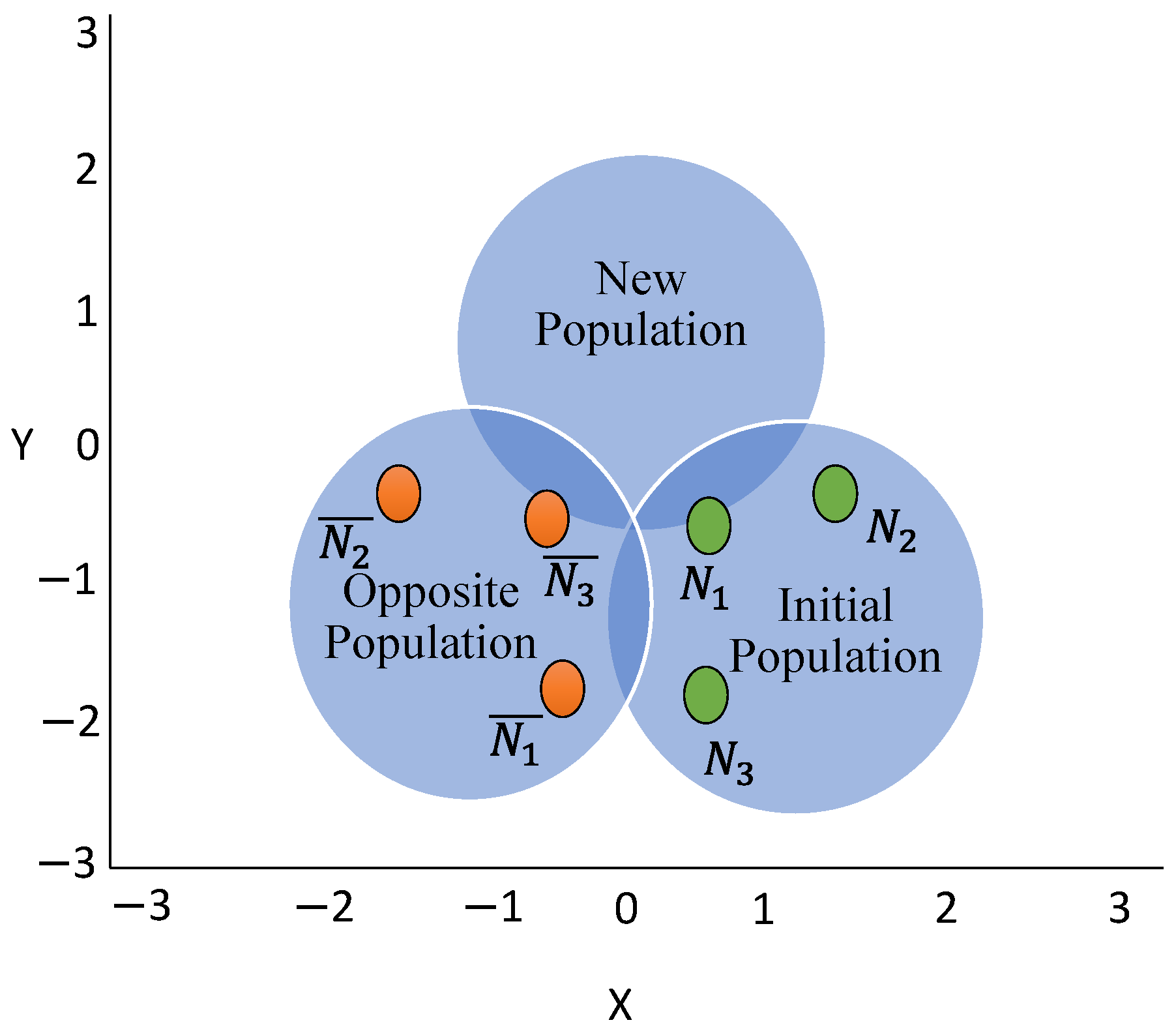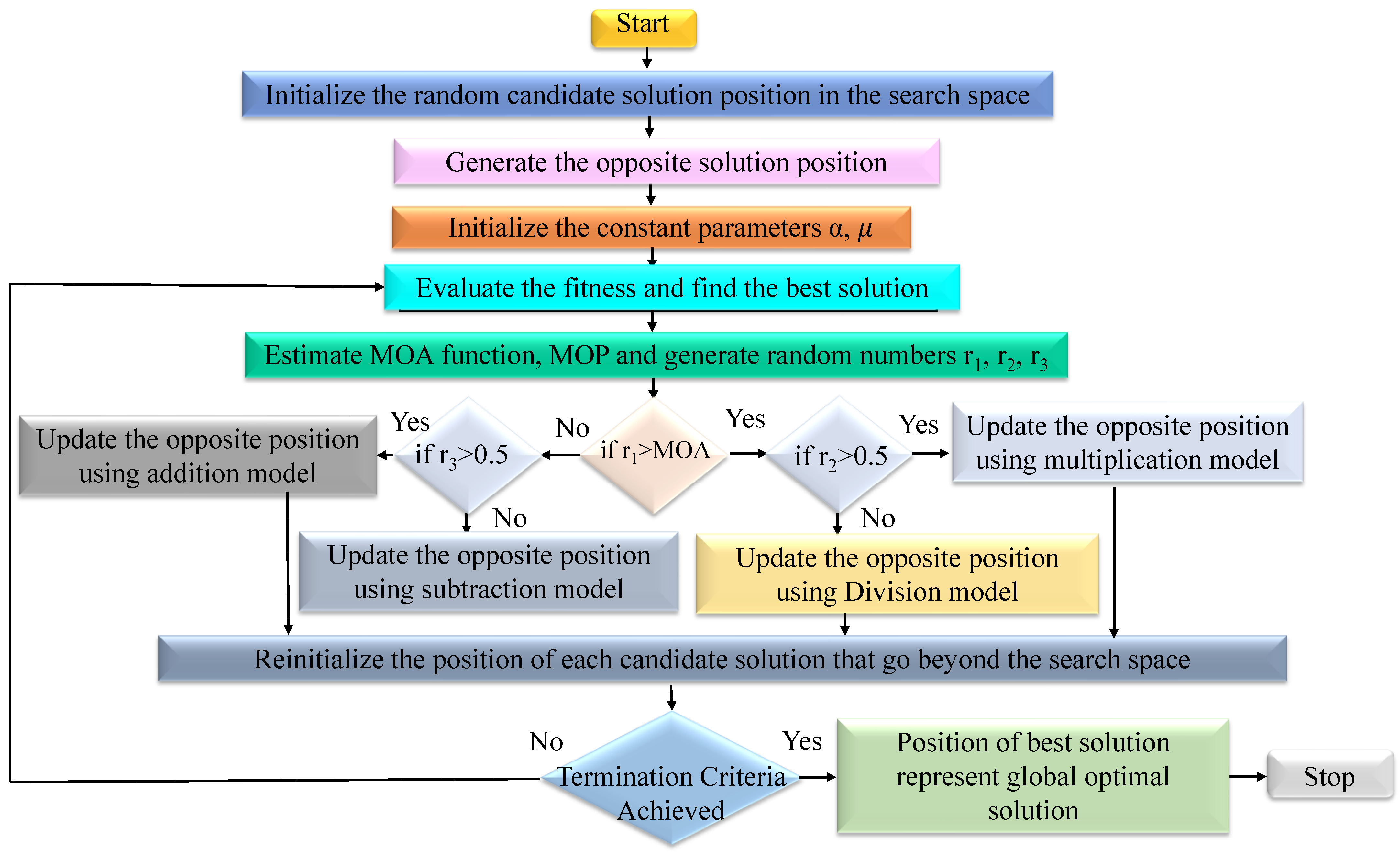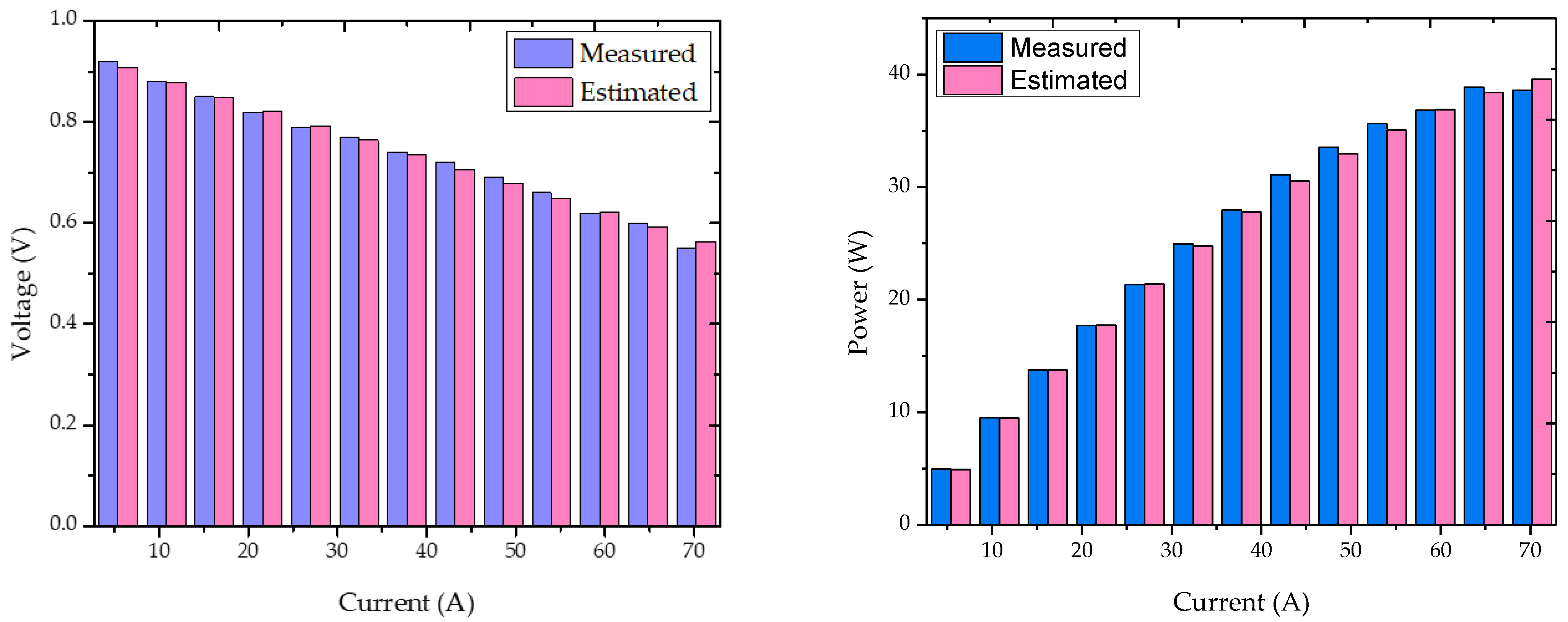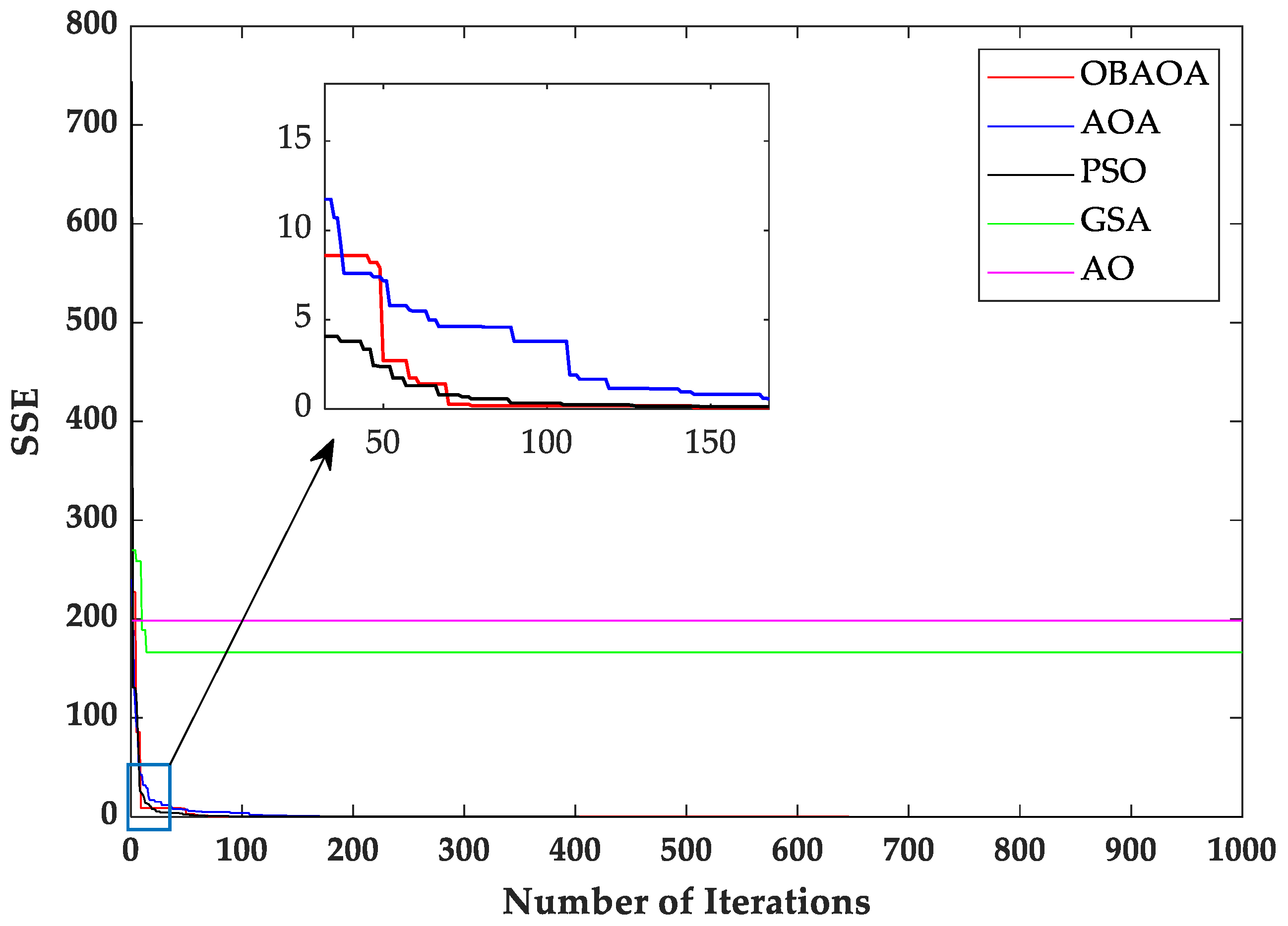1. Introduction
The demand for clean energy has kept increasing in recent years due to global warming and depleting oil reserves [
1,
2]. Fuel cells have drawn significant attention in recent years due to high efficiency and no emission of greenhouse gases. In recent years, fuel cell research has grown significantly due to possible applications such as stationary power generation and automotive applications [
3]. PEMFCs have particularly drawn attention for transport applications. It has many advantages such as low operating temperature, short start-up and shut-down time, high efficiency, no waste is generated as the by-product is water [
4,
5]. Due to compact size, low operating temperature, and quick start-up time makes PEMFCs a reliable candidate for medium power applications like smart grid, micro gird, and power electronic devices [
6]. The fuel cell has three main components: anode, cathode, and electrolyte. Both anode and cathode contain a layer of catalyst, which is separated by an electrolyte membrane to perform the redox reaction. However, the voltage (1.0 V) and current density (500–1000 mA/cm
2) delivered by a single cell is too low for any practical application, so a number of stacks are connected in series to deliver sufficient power for practical application. The performance of a fuel cell depends on multiple parameters such as operating temperature, inlet pressure of fuel and reactant, and conductivity of the membrane. In order to utilize fuel cell for wide range of application evaluation of performance under various operating conditions is necessary. Moreover, development of a mathematical model to simulate the dynamic variation in operating conditions and fuel cell performance is necessary for its integration in smart grid/microgrid [
7].
Both theoretical and experimental studies have been performed to optimize the factors affecting performance such as pressure, temperature, flow rate of fuel and oxidant, reaction kinetics, and membrane thickness to get the maximum power density from fuel cell [
8]. As the fuel cell performance depends on multiple interdependent factors, which makes it really difficult to develop a mathematical model to evaluate the multivariable, complex, and interrelated parameters affecting the fuel cell performance [
9]. In recent years, remarkable research and development has been performed to get a better understanding of the function of PEMFC characteristics via mathematical modeling. The modeling achieves great significance in the outlook of simulation, design, exploration, and progress of high-efficiency fuel cell systems [
10,
11,
12]. A reliable model facilitates monitoring of fuel cell behavior for process monitoring and designing a suitable power conditioning unit for various power applications. The development of a precise parameter estimation method using the experimental data is a pre-requisite to develop a mathematical model of fuel cell and design an appropriate power control algorithm [
13]. Two different approaches have been utilized to develop a mathematical model of the fuel cell systems. In the first approach, a mechanistic model is built to simulate the heat, mass transfer, reaction kinetics, membrane conductivity, and crossover of reactants through the electrolyte membrane encountered in fuel cells [
14,
15]. In this approach, a three-dimensional multiphase model of fuel cell system is developed, in which the gas and liquid two-phase flow in channel and porous electrodes are investigated in detail. This approach of precise estimation of model parameters is hindered by the nonlinear and complex relations of the electrochemical equations. In the second approach, a mathematical model is developed on the basis of empirical or semi-empirical equations, which are utilized to predict the effect of different input parameters on the voltage–current characteristics of the fuel cell, without examining the physical and electrochemical phenomena taking place in fuel cell system [
16]. The electrical equivalent models of fuel cell are mainly divided into static and dynamic models. The static models depends on steady-state operation of fuel cell based on polarization curve [
17,
18] and the dynamic models rely on characteristics of electrical terminal represented by a set of passive elements [
19,
20]. Although mechanistic models have been developed to evaluate the optimum parameters to get the maximum output from the fuel cell system, the actual performance of fuel cell observed in experimental studies is not precisely the same as observed in theoretical studies, irrespective of models, because of assumptions and approximations are made in modelling [
21]. In order to develop the precision of the models and make it reflect the actual fuel-cell performance, it is essential to improve the parameters of the models. However, a little effort has been put forward in the area of parameters optimization.
Generally, the statistics contained in any PEMFC datasheet are insufficient to determine the effective set of parameters. However, if the precise parameters are not specified, there are significant variations between the data obtained from the model and that listed in the manufacturer’s datasheet. PEMFC parameter identification can be approached as an optimization challenge, and a variety of meta-heuristic techniques can be implemented to find the best solution. Over the last ten years, various meta-heuristic optimization techniques have been applied to address the issue of PEMFC parameter estimation, which utilizes two important search strategies: (a) exploration/diversification and (b) exploitation/intensification [
22,
23]. The first method explores the search space globally, which avoids local optima and resolving local optima entrapment, whereas the second method explores the nearby promising solutions to improve their quality locally [
24]. A proper balance between these two strategies is required to get the optimum performance. The classification of meta-heuristics method is based in the evolutionary algorithms, swarm intelligence algorithms, physics-based methods, and human-based methods. However, there is no single optimized algorithm, which can solve all optimization problems. Most of the researchers either modify an existing algorithm or propose a new algorithm to get better result [
25]. Different meta-heuristic algorithms have been utilized for parameter optimization of PEMFCs such as particle swarm optimization (PSO) [
26], genetic algorithm (GA) [
27], artificial neural network (ANN) [
28], differential evolution (DE) [
29], artificial immune system (AIS) [
30], artificial bee colony (ABC) [
31], bird mating optimization (BMO) [
32], biography-based optimization (BMO) [
33], seeker optimization algorithm (SOA) [
34], backtracking search algorithm (BSA) [
35], improved teaching learning-based optimization (ITLBO) [
36]. Slime mold algorithm (SMA) [
37], moth-flame optimization (MFO) [
38], Archimedes optimization algorithm [
39], Jellyfish search algorithm (JSA) [
40], bonobo optimizer [
41], and hybrid GWO algorithm [
42] have been implemented to identify the unknown parameters of PEMFC. In this article, the authors have proposed an improved opposition-based arithmetic optimization algorithm for parameter extraction of PEMFC. To the best of the authors’ knowledge, arithmetic optimization algorithm (AOA) has not been explored in this field, therefore, in this article authors have examined the performance of improved AOA for parameter extraction of fuel cells.
The main contribution of this research paper is as follows:
An improved arithmetic optimization algorithm (AOA) algorithm is formulated that employs the opposition-based learning method for population initialization, preventing the accumulation of too many solutions in one location and resulting in a more efficient global search.
The performance of the proposed algorithm is evaluated on ten benchmark functions and experimental results clearly depicts that the OBAOA is very efficient and accurate.
The performance of proposed OBAOA algorithm is further accessed for parameter extraction of Ballard Mark V PEFMC.
The manuscript is organized as follows:
Section 2 describes the theoretical and mathematical model of the PEMFC,
Section 3 includes the formulation of OAOA technique.
Section 4 discusses the results and findings. Finally,
Section 5 provides the overall conclusive remarks of the proposed study.
2. Theory and Modeling of Proton Exchange Membrane Fuel Cell
There are three main components of a fuel cell: anode, cathode, and electrolyte. The fuel oxidation and oxygen reduction take place at anode and cathode, respectively. An electrolyte membrane separates the anode and cathode and allows conduction of protons to complete the electric circuit. The oxidation and reduction reaction are shown by Equations (1) and (2), respectively. The overall reaction is represented by Equation (3) [
43,
44].
At open circuit potential the cell voltage can be expressed by Equation (4):
At standard conditions (1.0 atm pressure and 25 °C), the fuel cell open circuit voltage (OCV) should be 1.229 V. However, the measured OCV at room temperature is around 1.0 V, due to the losses associated with the fuel cell. The cell voltage (
) is expressed by Equation (5) when the current (
) is drawn from the cell.
The activation overpotential of anode and cathode can be expressed as:
where
is the voltage drop due to the activation of redox processing the anode and cathode. The
represents the parametric coefficients for each cell model, whose values are defined based on theoretical equations with kinetic, thermodynamic, and electrochemical foundations (Mann et al., 2000). The oxygen concentration at the catalyst layer of the cathode (
, mol/cm
3) is given by:
The mass transport affects the concentrations of hydrogen and oxygen at the anode and cathode, which affects the partial pressures of gases. The change in partial pressure of fuel and reductant rely on the electrical current and on the physical features of the system. The voltage drop due to concentration polarization is represented as:
where
is a parametric coefficient (
V) that depends on the cell and its operation state, and
represents the actual current density of the cell (A/cm
2).
The ohmic drop (
) in Equation (5) is represented as:
where
is the resistance to the transfer of protons through the membrane (Ω),
is the charge transfer resistance,
is the specific resistivity of the membrane for the electron flow (Ω-m),
is the active area of the cell (cm
2) and
is the thickness of the membrane, which separate electrodes. The following numerical expression for the resistivity of the Nafion membrane is used:
where 181.6/(λ − 0.634) is the specific resistivity (Ω-cm) at OCV at 30 °C, the exponential term in the denominator is the temperature factor correction if the cell is operating at different temperature. The parameter
is an adjustable parameter with a maximum value of 24. This parameter is influenced by the preparation procedure of the membrane and is a function of relative humidity and stoichiometry relation of the anode gas.
If ‘
’ number of stacks are combined then the cell voltage is defined as:
At a given temperature (
), the partial pressure of fuel (
) and oxidant (
) is given by following equations:
If
and
are used as reactant then the partial pressure of oxygen and hydrogen is given as:
where
and
are relative humidity at the cathode and anode, respectively.
and
are the inlet pressure at cathode and anode, respectively. The
is partial pressure of nitrogen at the cathode. The
is saturated vapor pressure (atm), which is calculated as:
4. Results and Discussion
In this section, a benchmark test research approach was used to evaluate the proposed algorithm in the case of parameter identification for PEMFC.
Table 1 displays the ten benchmark test functions, one to seven of which are unimodal and the remaining functions are multimodal. Some well-known meta-heuristic algorithms, such as ant lion optimizer (ALO) [
51], dragonfly algorithm (DA) [
52], grasshopper optimization algorithm (GOA) [
53], and multiverse optimization (MVO) [
54] are especially compared to assess the precision and efficiency of the suggested algorithm. The statistical outcomes of benchmark test functions are shown in
Table 2. In this research paper, the benchmark functions are denoted by the letter “F” accompanied by a number (e.g., F1).
According to
Table 2, the proposed algorithm has the least mean and standard deviation (SD) values except for the F6. In the case of F6, ALO generates the best optimized value. Based on the benchmark test function, it is asserted that the proposed algorithm outperforms and outperforms the other compared algorithms in terms of effectiveness and precision.
To further validate the effectiveness of the proposed OBAOA algorithm, the practical case of Ballard Mark V PEMFC is considered. The experimental values of voltage and current are taken from [
55,
56]. The operating condition and technical specification of Ballard Mark V PEMFC is illustrated in
Table 3.
Table 4 depicts the lower and upper search bounds for the parameters similar to the other authors [
57,
58]. The simulation results are compared with the other optimization methods existing in the literature review. Moreover, to show the competence of OBAOA algorithm, four pre-existing algorithms: AOA [
48], PSO [
59], gravitational search algorithm (GSA) [
60], and acquilla optimizer (AO) [
61] are employed. For a reasonable comparative evaluation, the number of population and iterations are set at 30 and 1000, respectively. All simulations were run on a PC with an Intel (R) Core i5- CPU M370@2.4 GHz 8 GB and the MATLAB R2018b software.
4.1. Parameter Optimization of BALLARD MARK V PEMFC
Table 5 demonstrates the optimized value of all parameters by implementing the OBAOA algorithm. The number of cells connected in series in the Ballard Mark V model is 35, and the membrane thickness is 178 μm. It is clearly depicted in
Table 3 that the proposed OBAOA method is able to produce the least SSE of 9.03 × 10
−4 in comparison to other optimization methods. Here, SSE is taken for performance evaluation, which is same as considered by the other authors [
58,
62].
Furthermore, as depicted in
Table 6, the minimum and maximum value of internal absolute error (IAE) between experimental and simulated values is 0.0003 and 0.0139, respectively. The characteristics curve of current-voltage and power-voltage for Ballard Mark V PEMFC is redrawn and presented in
Figure 3, based on best-optimized parameters obtained by executing the OBAOA algorithm. This implies that the presented OBAOA technique outperforms other methods.
4.2. Convergence Analysis
Figure 4 describes the convergence curve for the Ballard Mark V PEMFC to evaluate the computational capability of the OBAOA technique.
Figure 4 shows that the developed OBAOA algorithm significantly outperformed the AOA, PSO, GSA, and AO algorithms in terms of convergence speed and produces a realistic solution for the same number of function evaluations (i.e., 1000).
The minimum value of SSE is produced by OBAOA. The values of SSE are 9.03 × 10−4, 2.16 × 10−3, 1.489 × 10−3, 1.665 × 102, and 1.985 × 102, respectively for OBAOA, AOA, PSO, GSA, and AO.
4.3. Statistical and Robustness Analysis
This section provides the statistical evaluations based on mean, minimum, maximum, and standard deviation in terms of SSE for all earlier suggested methodologies, as well as a comparison with the accuracy and robustness of the various algorithms in a total of thirty runs, as shown in
Table 7. The mean of the SSE is calculated to evaluate the algorithms’ accuracy, and the standard deviation is calculated to evaluate the dependability of the implemented parameter estimation technique.
The statistical analysis outcomes reveal that the developed OBAOA is the most accurate and efficient technique for parameter estimation because it has a very low standard deviation.
The Friedman rank test [
67] is applied to determine the relevance of the data in addition to the conventional statistical analysis, i.e., best, mean, worst, and standard deviation. Furthermore, for each analyzed PV module, this non-parametric test is used to rank the algorithms. The null hypothesis H
0 (
p-value > 5%) in the Friedman test suggests no notable change between the compared algorithms. The opposite hypothesis H
1 signifies a notable difference between the compared algorithms for all 30 runs. In this test, each algorithm is given a rank based on its performance. Small ranks determine the best algorithms.
Table 8 displays the Friedman rank test results at a 95% confidence level. According to
Table 8, the OBAOA has the first rank based on the Friedman ranking test results, followed by PSO, AOA, GSA, and AO.











